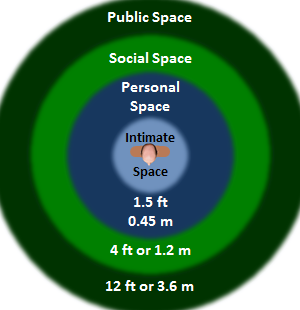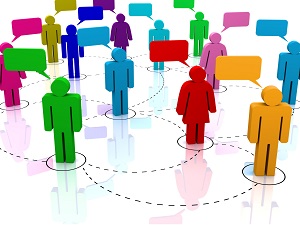07 Mar Your Personal Bubble
There is time-space context within which we constantly move and place ourselves in the universe. Our constantly moving and evolving personal bubble is the starting point of understanding. Where are you at this very moment? Are you where you want to be?
Where am I? Why am I here? Why isn’t the tide washing the sand off my feet?
| Understanding Context Cross-Reference |
|---|
| Click on these Links to other posts and glossary/bibliography references |
|
|
|
| Prior Post | Next Post |
| Inference in the Face of Uncertainty | In the Middle of a Big Wide World |
| Definitions | References |
| context | Walchover – Personal Bubble Dimensions |
| language communication | Chopra 2013 |
| emotion behavior | The Amygdala |
Communication Context and Personal Space
 While everyone has their own space needs, there are typical dimensions for personal bubbles. “As we all know, cultural or individual differences in personal bubble diameters are all too often the cause of discomfort” says Natalie Wolchover on LiveScience. The diagram at right shows typical dimensions of the bubble. Wolchover describes these as average sizes of Americans’ personal bubbles. Ralph Adolphs, professor of psychology and neuroscience at the California Institute of Technology, says “It is important to keep in mind that personal space of course varies depending on culture and context, and that there are significant individual differences — so these numbers should just be taken to reflect the average.”
While everyone has their own space needs, there are typical dimensions for personal bubbles. “As we all know, cultural or individual differences in personal bubble diameters are all too often the cause of discomfort” says Natalie Wolchover on LiveScience. The diagram at right shows typical dimensions of the bubble. Wolchover describes these as average sizes of Americans’ personal bubbles. Ralph Adolphs, professor of psychology and neuroscience at the California Institute of Technology, says “It is important to keep in mind that personal space of course varies depending on culture and context, and that there are significant individual differences — so these numbers should just be taken to reflect the average.”
Professor Adolphs places the cognitive roots of this phenomenon in the emotional center of the brain: “The amygdala is activated when you invade people’s personal space,” he told Life’s Little Mysteries. “This probably reflects the strong emotional response when somebody gets too close to us. We confirmed this in a rare patient with lesions to this brain structure: she felt entirely comfortable no matter how close somebody got to her, and had no apparent personal space.”
 From world-wide broadcasts to the case of a reclusive individual writing his manifesto from an isolated cabin in the deep wilderness, language necessarily requires more than one person to be of much use. Of course, we learn from language, and that may seem to become an individual process if we isolate ourselves with stacks of books. But books are fundamentally social phenomena: writers using language to document what’s in their brains. More immediate forms of communication are even more collaborative and social. Some observers have suggested that the expanding technology of human intercourse, especially social media sites that encourage remote, and sometimes shallow communication, depersonalizes interaction. I take a different view. Humans have always known how to communicate, and more tools to facilitate it can only help.
From world-wide broadcasts to the case of a reclusive individual writing his manifesto from an isolated cabin in the deep wilderness, language necessarily requires more than one person to be of much use. Of course, we learn from language, and that may seem to become an individual process if we isolate ourselves with stacks of books. But books are fundamentally social phenomena: writers using language to document what’s in their brains. More immediate forms of communication are even more collaborative and social. Some observers have suggested that the expanding technology of human intercourse, especially social media sites that encourage remote, and sometimes shallow communication, depersonalizes interaction. I take a different view. Humans have always known how to communicate, and more tools to facilitate it can only help.
I suspect it is neither advisable nor even possible to block the evolution of communication (Chopra 2013). Communication is deeply personal, and completely social.
Different Schools of Thought
The processes we use to reason about the world around us have been studied by philosophers for centuries. The scientific techniques used to explore and experiment with social philosophy, behavior and attitudes are still intensively human. Unlike research in the hard sciences, the techniques use less machinery, and more methodical elicitation and observation. While other scientific techniques that produce observable results are more precisely measurable, social science techniques are very valuable. This is why philosophy has been called a soft science. The perpetual polarization in different schools of thought testify to the softness (meaning room for multiple interpretations) of some of the techniques used to analyze the tremendous body of experimental results generated over the years.
 Throughout this study, we try to frame arguments in a larger context which attempts to understand the nature of life, thought, and the universe. The universe may be an overly large playground, but if we make our assumptions plain in the beginning, we avoid misunderstandings later on. The key connection with the universe is that there may be a universal structure that applies to all information. Such a universal structure may influence our research into how humans (and computers) deal with complex information. Application of some physical laws govern our interpretation of the mechanisms of logic and reasoning. Knowledge of physical laws influences our interpretations of chaos, randomness, and threshold logic. Finally, this structure and these laws and constraints can be applied to cybernetic modeling.
Throughout this study, we try to frame arguments in a larger context which attempts to understand the nature of life, thought, and the universe. The universe may be an overly large playground, but if we make our assumptions plain in the beginning, we avoid misunderstandings later on. The key connection with the universe is that there may be a universal structure that applies to all information. Such a universal structure may influence our research into how humans (and computers) deal with complex information. Application of some physical laws govern our interpretation of the mechanisms of logic and reasoning. Knowledge of physical laws influences our interpretations of chaos, randomness, and threshold logic. Finally, this structure and these laws and constraints can be applied to cybernetic modeling.
| Click below to look in each Understanding Context section |
|---|









